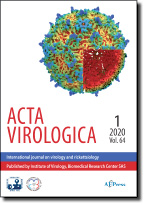Acta Virologica Vol.60, No.3, p.260-270, 2016
|
| Title: Sequence analysis and structural implications of rotavirus capsid proteins |
| Author: N. PARBHOO, J. B. DEWAR, S. GILDENHUYS |
|
Abstract: Rotavirus is the major cause of severe virus-associated gastroenteritis worldwide in children aged 5 and younger. Many children lose their lives annually due to this infection and the impact is particularly pronounced in developing countries. The mature rotavirus is a non-enveloped triple-layered nucleocapsid containing 11 double stranded RNA segments. Here a global view on the sequence and structure of the three main capsid proteins, VP2, VP6 and VP7 is shown by generating a consensus sequence for each of these rotavirus proteins, for each species obtained from published data of representative rotavirus genotypes from across the world and across species. Degree of conservation between species was represented on homology models for each of the proteins. VP7 shows the highest level of variation with 14–45 amino acids showing conservation of less than 60%. These changes are localised to the outer surface alluding to a possible mechanism in evading the immune system. The middle layer, VP6 shows lower variability with only 14–32 sites having lower than 70% conservation. The inner structural layer made up of VP2 showed the lowest variability with only 1–16 sites having less than 70% conservation across species. The results correlate with each protein’s multiple structural roles in the infection cycle. Thus, although the nucleotide sequences vary due to the error-prone nature of replication and lack of proof reading, the corresponding amino acid sequence of VP2, 6 and 7 remain relatively conserved. Benefits of this knowledge about the conservation include the ability to target proteins at sites that cannot undergo mutational changes without influencing viral fitness; as well as possibility to study systems that are highly evolved for structure and function in order to determine how to generate and manipulate such systems for use in various biotechnological applications.
|
|
| Keywords: rotavirus; capsid protein; amino acid sequence conservation; protein structure; consensus; vaccine candidate |
|
|
Published online: 13-Sep-2016
|
| Year: 2016, Volume: 60, Issue: 3 |
Page From: 260, Page To: 270 |
doi:10.4149/av_2016_03_260
|
|
 download file download file |
|
|
|
|
 download file
download file
